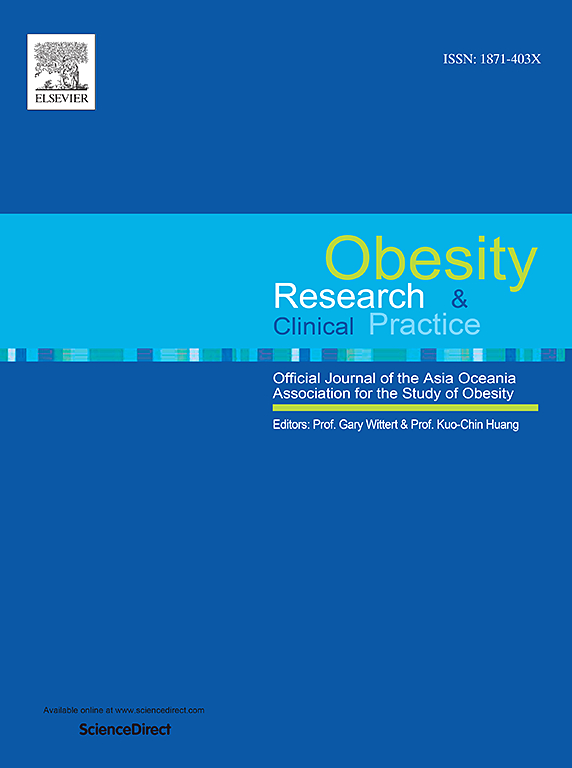Insulin resistance and vigorous physical activity mediates the relationship between waist circumference and metabolic syndrome in Korean children
IF 2.5
4区 医学
Q3 ENDOCRINOLOGY & METABOLISM
引用次数: 0
Abstract
Background
Little is known about how physical activity (PA) and insulin resistance (IR) influence the impact of obesity on metabolic syndrome in pediatric populations.
Objectives
This cross-sectional observational study aimed to investigate the mediating effects of PA and IR on the relationship between waist circumference (WC) and continuous metabolic syndrome (cMetS) risk scores in children.
Methods
A total of 1008 children aged 7–12 years (535 girls and 473 boys) were recruited from our local elementary schools. PA, body mass index (BMI), WC, and percent body fat were measured. cMetS risk scores were calculated by summing the standardized residuals for mean arterial pressure, triglycerides, fasting blood glucose, and high-density lipoprotein cholesterol.
Results
Mediation analysis showed a significant indirect effect of WC on cMetS scores through insulin (β= 0.270, 95 % confidence interval [CI = 0.234–0.306) and vigorous PA (β= 0.007, 95 % CI = 0.001–0.015). The direct effect of WC on cMet scores in the presence of the two mediators was significant (β= 0.193, 95 % CI = 0.040–0.066).
Conclusion
Our study findings suggest that while WC is the primary determinant of cMetS scores, fasting insulin and vigorous PA partially mediate the association between the two parameters in this study population.
胰岛素抵抗和剧烈运动介导韩国儿童腰围与代谢综合征的关系。
背景:在儿童人群中,体育活动(PA)和胰岛素抵抗(IR)如何影响肥胖对代谢综合征的影响,我们知之甚少。目的:本横断面观察性研究旨在探讨PA和IR在儿童腰围(WC)与持续代谢综合征(cMetS)危险评分之间的中介作用。方法:选取当地小学7 ~ 12岁儿童1008名,其中女生535名,男生473名。测量PA、体重指数(BMI)、WC和体脂百分比。通过将平均动脉压、甘油三酯、空腹血糖和高密度脂蛋白胆固醇的标准化残差相加来计算cMetS风险评分。结果:中介分析显示,WC通过胰岛素(β= 0.270, 95 %置信区间[CI = 0.234-0.306])和剧烈运动PA (β= 0.007, 95 % CI = 0.001-0.015)对cMetS评分有显著的间接影响。两种介质存在时,WC对cMet评分的直接影响显著(β= 0.193, 95 % CI = 0.040-0.066)。结论:我们的研究结果表明,虽然WC是cMetS评分的主要决定因素,但在本研究人群中,空腹胰岛素和剧烈PA部分介导了这两个参数之间的关联。
本文章由计算机程序翻译,如有差异,请以英文原文为准。
求助全文
约1分钟内获得全文
求助全文
来源期刊

Obesity research & clinical practice
医学-内分泌学与代谢
CiteScore
7.10
自引率
0.00%
发文量
80
审稿时长
49 days
期刊介绍:
The aim of Obesity Research & Clinical Practice (ORCP) is to publish high quality clinical and basic research relating to the epidemiology, mechanism, complications and treatment of obesity and the complication of obesity. Studies relating to the Asia Oceania region are particularly welcome, given the increasing burden of obesity in Asia Pacific, compounded by specific regional population-based and genetic issues, and the devastating personal and economic consequences. The journal aims to expose health care practitioners, clinical researchers, basic scientists, epidemiologists, and public health officials in the region to all areas of obesity research and practice. In addition to original research the ORCP publishes reviews, patient reports, short communications, and letters to the editor (including comments on published papers). The proceedings and abstracts of the Annual Meeting of the Asia Oceania Association for the Study of Obesity is published as a supplement each year.
 求助内容:
求助内容: 应助结果提醒方式:
应助结果提醒方式:


